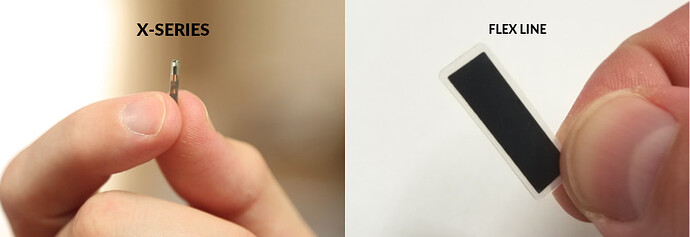The primary reason we have two types of chip implant designs has to do with performance. There are other reasons as well, however performance is the driving factor.
The x-series product line
Our x-series products are tube shaped and injected with a syringe. They all have product names featuring x somewhere in the name, like xNT or xEM or xM1 or xSIID or even the NExT. We even have x-series implantable products that are not chip implants at all, like the xG3 and the xLED.
The good
- easily injected with syringe and needle assembly
- come pre-loaded in EO gas sterilized syringes
- our professional partners, body piercers, nurses, etc. can safely install
- safe and well tested materials used for pets and animals for decades
The not so good
- shape and size can make x-series harder to read
- difficult to fit larger more capable silicon chips into small tubes
The flex product line
The flex product line was created to address certain performance requirements from some of our customers. Passive RFID works by magnetically coupling with the reader antenna, and the best way to do that is to make the chip antenna identical to the reader antenna in shape an size. The problem is, almost all reader antennas are big flat squares or rectangles designed to read access cards, key fobs, contactless payment cards, etc. The small cylindrical shaped antennas inside the x-series implants is about as far away from “identical shape” as you can get from most reader antennas. Still, there is a trick to getting good reads from an x-series chip implant which I will cover later.
Flex products were created using larger, traditionally flat chip antennas that better matched reader antenna shapes. To make these chips safe to implant, we developed a custom biopolymer that is very thin and flexible. That’s how “flex” became the name of this product line even though some products covered in this biopolymer are actually quite rigid and do not flex.
The good
- better performance than x-series, sometimes much better
- wider range of specialized chip options and capabilities
- some are installable with a modified needle procedure
The not so good
- even with the needle procedure, these are not injectable
- much larger in size, some flex require a scalpel procedure and sutures
- harder to find professional help to get flex installed safely
Getting good reads with x-series
As I mentioned above, it is possible to get good reads using an x-series chip implant with a standard reader that has a large flat antenna (pretty much all readers you will ever encounter). The trick is to hold the x-series implant perpendicularly across the antenna path. We include a special tool with our x-series chip implants called an xFD or Field Detector. This video explains how to use it;
Again, because this tool is so critical to understanding how to get a good read with your x-series chip implant, the xFD is always included with all x-series chip implants.
How are biohacking implants safely installed?
Our x-series implants are injectable devices which should be easily installable by medical professionals or professional body piercers (not tattoo artists). We partner with such professionals and maintain a map of these partners.
Other devices like certain flex implants and magnets like the Titan will require more advanced installation methods. In these cases you will want to involve a professional surgeon or a professional body modification artist who can safely use scalpels and sutures. We also partner with such professionals, represented on our partner map by red pins.

